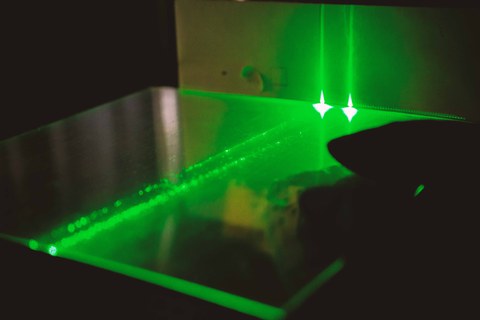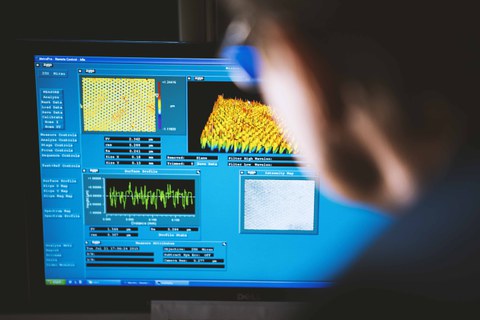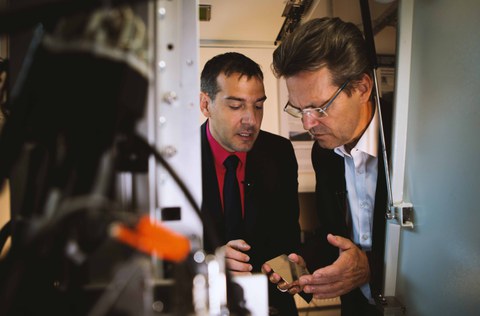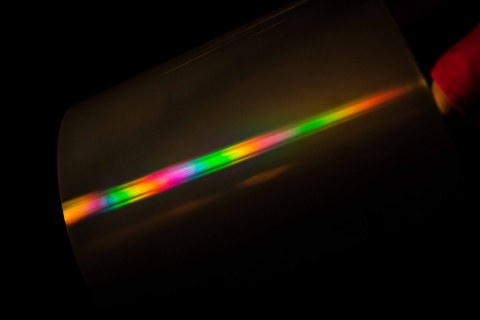Berthold Leibinger Award 2016
Laser beams stamp microstructures – Direct Laser Interference Patterning
© Berthold Leibinger Stiftung
“Surface functionalization” – a cumbersome term but at the same time a magic word. Two prominent examples of nanopatterned and micropatterned surfaces with functional properties are the water-repellent lotus effect and friction-reducing sharkskin.
Depending upon material and requirements, very different processes are used in the production of functional surfaces. Lasers add a high degree of flexibility. On the one hand, they can penetrate deep into a material by means of targeted heat input, on the other hand, they can also work “cold” through the use of ultrashort pulses. However, the processing times present a great challenge.
A simple calculation demonstrates just how great this challenge is: depending upon thumb size, several 100 millions of structures one micrometer in size have room on a thumbnail. Even if one thousand of these structures could be produced in one second, it would still take more than a day to pattern this small surface.
Thus, broad-scale technical applications would only be imaginable if thousands, millions or even better billions of the tiny structures could be produced at the same time. This would become possible through effects that would allow these structures to generate by themselves or if they could be printed. However, neither option leaves room for flexibility.

Light guiding of two laser beams in the green spectral range
At Saarland University, Frank Mücklich used a simple optical effect to combine the flexibility of the laser with areal processing. He thus found a compromise between long-standing setup and inflexible mask technology. Through the overlapping of two or more laser beams a so-called interference patterns are generated.
These patterns can be calculated and it is possible to adjust the laser beams to achieve these interference effects. On areas as large as the beam diameter - meaning square millimeter to square centimeter - periodical micro and nano structures are generated. The overlapping laser beams can fabricated millions to billions small structures within only one "shot”.
Together with his working group, Frank Mücklich studies functional materials and has a passion for laser technology. However, he is not satisfied with just publishing his scientific findings and producing samples for laboratories, he also wants the diverse, fascinating abilities of his materials to find a place in everyday life.

Scientific analysis of microstructures
To achieve this, he founded the Steinbeis-Forschungszentrum Material Engineering Center Saarland n 2009 as a transfer institute for industrial collaborations.
SSimilar to his doctoral advisor Mücklich, Andrés Lasagni at Dresden University of Technology also believes in transferring his technologies to practice. He is specialized in large surface micropatterning and nanopatterning and, together with his team at the Fraunhofer Institute for Material and Beam Technology Dresden, has developed a range of systems for different laser interference patterning applications that are ready for industrial use.

Prof. Lasagni and Prof. Mücklich explain the mode of action of the laser interference facility
Prof. Lasagni and Prof. Mücklich explain the mode of action of the laser interference facility. Thus the know-how and systems necessary for producing functionalized surfaces are available to users today.
Ideas and requests abound. Next to classic applications such as the minimization of wear on lubricated surfaces, antibacterial properties are also in demand, as are implant surfaces that facilitate cell accumulation for improved grafting processes. Improvements in the efficiency of solar cells are planned. Electrical plug-in connections are also to become more reliable in the future, ensuring that loose connections will not have a negative impact on driver assistance systems or autonomous driving features.

Large area patterned Nickel sleeve for embossing in roll-to-roll systems
In addition to Mücklich und Lasagni, the second prize of the 2016 Berthold Leibinger Innovation Award will go to the following contributors for research and development of both the processes and systems: Dr. Carsten Gachot, Dr. Andreas Rosenkranz, Dr. Michael Hans, Dr. Kim Eric Trinh in Saarbrücken and Dr. Teja Roch, Matthias Bieda, Sebastian Eckhardt, Dr. Denise Günther, Dr. Tim Kunze, Valentin Lang in Dresden.
